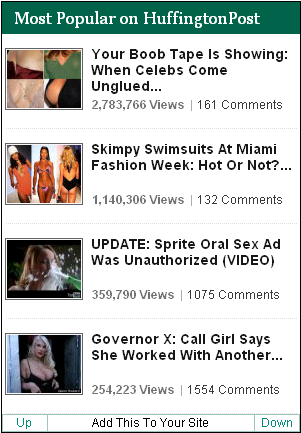Who’s Reading What
Matt Yglesias notes that bloggers and others who write for the Web lack a luxury of those who write for print: “nobody has any idea who’s reading them.” Whereas there are detailed metrics about pageviews on the Web, all print has to go on is circulation figures. So they can blithely assume that their long features and hard news and the like are being widely read, whether it’s true or not.
 Some time back, Steve Graham touched some raw nerves by pointing out that:
Some time back, Steve Graham touched some raw nerves by pointing out that:
Most blog traffic is trash. I’ve written about it before, and it’s not exactly news. Everyone knows it. If you look at your stats, you’ll learn that half of your traffic—or a lot more than half—comes from search engines. People type in things like “nipple schoolgirl goat priest molasses,” and they end up at your site for ten seconds, and they leave, hopefully disappointed. Those people aren’t “visitors,” no matter how much you like to think they are. They’re just lost. And they don’t click ads. Even worse, you may be getting traffic because big bloggers link to you. That doesn’t make you a success. It makes you a pet, living on table scraps. When the scraps stop coming—when you say the wrong thing and stop toadying—those tasty scraps can stop coming, instantly, and then you find out how much readers really care about you.
This morning, Henry Copeland pointed out that Huffington Post has changed the display settings on its “Most Popular” widget to hide the fact that much of its traffic comes from salacious junk.
Apparently embarrassed by the importance of sex-driven stories in powering its traffic, Huffpo has recently changed its “most popular stories” feature to obscure how many page impressions each story gets.
The stories now seem to be ranked according to # of comments (see example of the new format at the bottom of the post) but earlier this summer, you could see the number of raw impressions each story was getting.
While serious policy-related “politics” stories, which Huffpo pretends are its bread and butter, got 50k impressions, stories like “When your Boob tape is showing” and “Women’s Iconic Swimsuit movie moments” got millions.
But, alas, that’s what people are interested in. I’ve written more than 35,000 blog posts over the past six-and-a-half years and gotten a lot of satisfaction from getting traffic and commentary to substantive commentary. All too frequently, though, those pieces get ignored and crap posts that took ten minutes to write go viral.
National Enquirer, FauxNews, etc…..Rupert Murdock…..the king of all crap…..equals mucho dinero…..
give us dirty laundry…..with lotsa pics….
Naturally I can’t get a similar result 🙁
Yes, it’s very surprising that people would prefer pictures of firm, round, juicy breasts over endless provocative dissections of the differences between single-payer and public option.
In any well-run world we would shy away from a story about Megan Fox’s near-perfect ass peeking out from shorts that are obviously too small for the poor girl and instead click on the link to: Helmand Province Is a Hopeless Craphole.
Why are people (men) like this? Why, when given a straight-up choice between this photo and this photo show such a clear preference for option #1?
@Michael Reynolds Why, indeed!
Heh, that’s not the “most popular” Huffington shows me … what’s in your cookies, James?
@odograph: That’s a screencap from Henry Copeland’s linked piece. That’s what the widget used to show before they started doing it by comments vice pageviews.
That is kind of amazing. One wonders how much of it was incoming links, and how much was The Justin Timberlake Effect.
Good points Harry, good points!!!!
http://www.gobollywood.com/pictures/scarlet-johanson.jpg